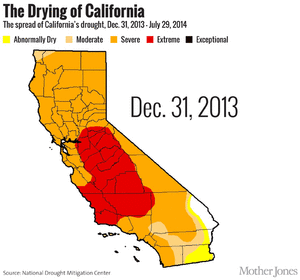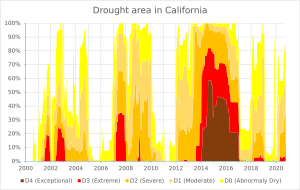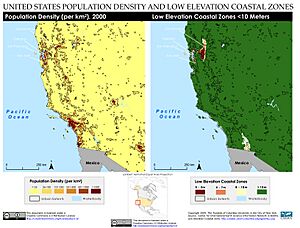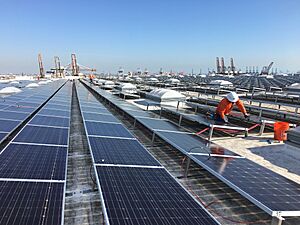Climate change in California facts for kids
Climate change in California means the state is getting warmer. This leads to more droughts and wildfires. In the next few decades, climate change is expected to cause even less water to be available. It will also increase wildfire risks and affect farming. Coastal areas and their plants and animals are also in danger. California's economy could be hurt too. This is because water might cost more, and farming jobs and money could be lost. Prices for things like insurance, energy, and food might also go up. California is working hard to deal with these changes.
Contents
California's Past Climate
Scientists who study Earth's past climate, called paleoclimatologists, say that the last 150 years in California have been unusually wet. This is compared to the 2,000 years before that. Tree stumps found at the bottom of lakes and rivers show that many water areas dried up long ago. Trees grew there when the water was gone. These dry times happened during warm periods in Earth's history. For example, during the Medieval Warm Period, there were at least two very long droughts. These "megadroughts" lasted for a century (100 years) or more. During these times, California got only 60–70% of the rain it gets today. Paleoclimatologists think that rising temperatures from global warming could cause California to have another very dry period. This would mean much less rain and snow than we have seen in the last 150 years.
Extreme Weather Changes
A study from 2011 predicted that both the highest and lowest temperatures would happen more often and be more extreme. This is due to global warming. The Fifth National Climate Assessment from 2023 reported that states like California are seeing "more significant storms and extreme swings in precipitation."
Wildfires
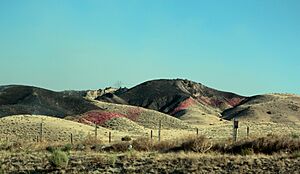
Warmer weather, frequent droughts, and how land has been managed make people and nature more likely to be affected by wildfires. Wildfires are closely linked to temperature and how dry it is. Around the world, the fire season has gotten almost 19% longer from 1979 to 2013. In the western United States, the seasons are much longer. More than half of the area burned by wildfires in the western U.S. is due to human-caused climate change.
Also, the way people have tried to stop fires in the past has caused a lot of dry plants and trees to build up. This makes them more likely to burn in some areas. Now, there's a higher risk of fires in thick, dry forests. Historically, fires happened more in areas with fewer trees. Finally, as more people move into areas at high risk for wildfires, more homes and lives are in danger. Since 1990, the number of homes lost to wildfires each year has gone up by 300%. By 2017, almost 900,000 homes in the western U.S. were in high-risk wildfire areas. Nearly 35% of California's wildfires start in these areas.
Many studies show that climate change is causing more large and powerful wildfires in California. The cost of recent fire seasons, including health problems from smoke, has been as high as $148.5 billion. This is about 1.5% of California's yearly economy. Most of this damage comes from air pollution caused by smoke. As global warming continues, the risk of climate-driven wildfires is expected to increase.
In 2019, after "red flag" warnings for wildfires, the electricity company Pacific Gas and Electric (PG&E) started turning off power. This was to stop trees from touching power lines and starting fires. Millions of people were affected. The weather conditions that cause these warnings are happening more often because of climate change. If temperatures keep rising, these power outages could become common.
Recent wildfire seasons have broken many records. The 2018 season was the deadliest and most destructive in California's history. It killed 103 people and damaged or destroyed 24,226 buildings. The 2020 season was the largest ever recorded in the state. More than 4 million acres burned in 9,917 wildfires. Five of the six biggest fires ever in California happened in 2020.
A 2017 study found that the biggest threat to hospitals in Los Angeles County from climate change is the direct impact of more wildfires. In Los Angeles County, 34% of hospitals are within one mile of high fire risk zones. The study also noted that one hospital was at risk of coastal flooding due to climate change. This problem will get worse as sea level rises from higher temperatures.
Drought
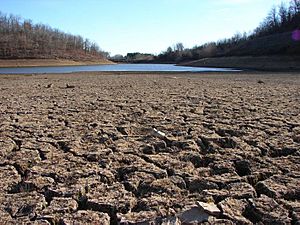
In February 2022, scientists said that the drought in the southwestern U.S., including California, from 2000–2021 was the worst in 1,200 years. This is as far back as their records go. Without climate change, the drought might have ended by 2005. About 42% of how bad the drought was is due to rising temperatures from climate change. 88% of the area was affected by drought. The flow of the Colorado River, which provides water to seven states, had "shrunk to the lowest two-year average in more than a century." If temperatures keep rising, the drought will get worse.
In February 2014, the drought in California caused the California Department of Water Resources to plan for cutting water to farms by up to 50%. During that time, California's 38 million residents had 13 months of continuous drought. This is a big problem for the state's $44.7 billion farming industry. This industry grows almost half of all American fruits, nuts, and vegetables. NASA reported in January 2014 that the 12 months before that were the driest since records began in 1885. Because of low snowpack (the amount of snow on mountains), California's governor, Jerry Brown, ordered strict water limits on April 1, 2015.
Megafloods
A study in Science Advances in 2022 said that climate change has already doubled the chance of huge floods, called megafloods, in California since 1920. These floods can bring 100 inches (254 cm) of rain or melted snow in the mountains each month. Or they can bring 25 to 34 feet (7.6 to 10.4 m) of snow in the Sierra Nevada mountains. In a future extreme storm, the amount of water runoff in the Sierra Nevada is predicted to be 200 to 400% greater than in the past.
Forest Management
Between 2012 and 2016, 129 million trees in California died from drought and bark beetles. This included sugar pines around Lake Tahoe that had survived droughts before. Thousands of young trees grown from seeds of these surviving pines are being planted. They are going on south-facing slopes on the north side of the lake basin. The hope is that these trees have genes that make them stronger against drought, less snow, and other effects of global warming in the Sierra Nevada forests.
The 2022 IPCC report on climate change suggests that California's land managers need to think about the changing climate. This is especially true when updating how they manage forests, given the huge number of wildfires. The report suggests that "prescribed burning," which is a common way to manage land and fires, might not always help. It often adds carbon to the air, making climate change and wildfires worse.
Agriculture
Longer periods of higher temperatures are expected to increase the number of navel orangeworms. This will lead to more insect damage to almond, walnut, and pistachio crops.
Conservation groups are working with farmers in Central California to flood fields for parts of the year. This helps create more living space for animals affected by climate change, like salmon and migratory birds.
Climate change's effect on rain in California can cause severe droughts. During droughts, farmers leave some of their land unplanted, or "fallow." In the 2014 drought, 430,000 acres of farmland were left fallow. Farmers expected to leave a similar amount of land fallow in 2022.
Fisheries Impact
Ocean heat waves since 2013 have caused delays in three Dungeness crab fishing seasons. This is because harmful algal blooms contaminate the crab meat.
Sea Level Rise
A 2017 study said that if sea levels rise by 1 to 2 meters (about 3 to 6.5 feet), one-third to two-thirds of Southern California beaches will be underwater. Sea levels off the coast are expected to rise 20–55 inches (51–140 cm) over the next century. Rising sea levels destroy ocean life, cause permanent floods, and erode coastlines. An economic study found that if greenhouse gas emissions continue as they are, between $8 billion and $10 billion worth of property in California could be underwater by 2050. Another $6 billion to $10 billion could be at risk during high tides.
Health Impacts
More extreme weather could lead to more illnesses and deaths. Various diseases will affect Californians because of climate change. "Breathing wildfire smoke has been linked to health problems. These include breathing infections, heart attacks, low birth weight, mental health issues, and worse asthma. Long-term exposure to wildfire smoke caused an estimated $76 billion to $136 billion per year in health costs across the U.S. from 2008 to 2012. Some of the biggest impacts were in northern California."
Heat Waves

A study from May to September between 1999 and 2003 looked at nine California counties. It found that for every 10°F (5.6°C) increase in temperature, there was a 2.6% increase in deaths from heart problems.
2006 Heat Wave
A study of the 2006 California heat wave showed a big increase in people needing medical help. There were 16,166 more emergency room visits and 1,182 more hospital stays. Heat-related illnesses also increased a lot. Emergency room visits for heat went up six times, and hospital stays went up ten times.
A study of seven counties affected by the 2006 heat wave found a 9% increase in daily deaths for every 10 degrees Fahrenheit change in how hot it felt. This was for all counties combined. This number is three times higher than what was expected for the rest of the warm season. The studies suggest that the actual number of deaths during the 2006 heat wave was two or three times higher than the first estimate of 147 deaths.
Air Pollution
Research shows that most health problems from air pollution are caused by ozone (O3) and tiny bits of dust and soot called particulate matter (PM). Other pollutants linked to climate change, like nitrogen dioxide, sulfur dioxide, and carbon monoxide, also cause health issues.
Five of the ten most ozone-polluted cities in the United States are in California. These are Los Angeles, Bakersfield, Visalia, Fresno, and Sacramento. Californians suffer from many health problems due to air pollution. This includes 18,000 early deaths from breathing problems and other illnesses.
Climate change may make air pollution worse. Higher temperatures speed up chemical reactions between nitrogen oxide, gases from pollution, and sunlight. This leads to more ozone in city air. A study found that for every 1 degree Celsius (1°C) rise in temperature in the United States, there are an estimated 20–30 more cancer cases. There are also about 1,000 (possibly 350–1,800) more deaths each year linked to air pollution. About 40% of these extra deaths may be due to ozone, and the rest to particulate matter. Three hundred of these yearly deaths are thought to happen in California.
Economic Impacts
Inflation
Economic problems also include inflation, which means prices go up. This happens because of rising insurance premiums, higher energy costs, and more expensive food prices.
Gross Domestic Product
The Natural Resources Defense Council (NRDC) estimates that if things continue as they are, the cost of providing water to the western U.S. will increase. Between 2025 and 2100, it could go from $200 billion to $950 billion per year. This is about 0.93–1% of the United States' total economic output (GDP). Four climate change impacts alone—hurricane damage, energy costs, real estate losses, and water costs—are expected to cost 1.8% of the U.S. GDP. This is almost $1.9 trillion in 2008 dollars by the year 2100.
Job Opportunities
A study from 2009 showed that more frequent and intense extreme weather due to climate change will reduce how much farms can produce. This will lead to less money for farms and possibly job losses. Changing weather and rain patterns might require expensive changes. For example, moving where crops are grown, changing what crops are grown, or using more pesticides. These changes can hurt the economy and cause people to lose jobs. Climate change negatively affects farming in California, leading to more job losses for farm workers. For example, California's two most valuable farm products are dairy ($3.8 billion yearly) and grapes ($3.2 billion yearly). Climate change is also expected to hurt the ripening of wine grapes, greatly lowering their market value.
Laws and Actions
California has taken many steps and started many projects to deal with climate change. They aim to prevent and reduce the risks of global warming effects. This includes many ways to encourage clean cars, renewable energy, and pollution controls on industries. California is known for being a leader in environmental laws, not just in the U.S. but globally.
In 2007, California passed AB 32, the Global Warming Solutions Act of 2006. This law required the state to reduce greenhouse-gas emissions to 1990 levels by 2020. It gave the California Air Resources Board (CARB) the job of creating a plan to do this. AB 32 matched Governor Arnold Schwarzenegger's 2005 order, which also required California to cut its emissions to 80% below 1990 levels by 2050. CARB updated this plan in 2014.
In 2016, SB 32 was passed. This law set California's climate goals beyond 2020. It required a 40% reduction below 1990 levels by 2030 and an 80% reduction by 2050. CARB's 2017 plan, which explains how the state will meet SB 32, set goals for greenhouse gas emissions per person. They must be reduced to 6 metric tonnes of carbon-dioxide equivalent by 2030, and 2 metric tonnes by 2050. CARB's 2022 plan continues to work on SB 32.
Wildlife Impacts
Climate change is greatly affecting wildlife in California. It is changing where animals live, how many there are, and how different species interact. As temperatures rise, many animals are moving to higher places or further north. Some bird species from the south are now nesting regularly in California. These changes are causing a lot of habitat loss. Predictions suggest that between 21% and 56% of California's natural areas might become unsuitable for their current ecosystems by 2100. Some ecosystems, like pinyon-juniper woodlands and freshwater marshes, could lose up to 97% of their suitable habitat.
Some animals that could be affected include:
- California Spotted Owl: These owls need stable forest homes with large, old trees. Droughts and extreme weather from climate change disrupt these homes. This affects their ability to reproduce and survive.
- Central California Coast Coho Salmon: These salmon are sensitive to habitat changes from more droughts and floods. Climate change can damage their spawning grounds, affecting how many eggs and young fish survive.
- Sacramento River Winter-Run Chinook Salmon: Rising temperatures and less water due to climate change threaten their spawning success. They need cold water to lay their eggs.
- Desert Slender Salamander: This amphibian needs moist places to live. These places are drying out more and more because of higher temperatures and less rain from climate change.
See also
- 2012–2013 North American drought
- 2014 California wildfires
- 2013 California wildfires
- California Environmental Protection Agency
- Climate change in the United States
- CoolCalifornia.org
- Effects of global warming
- List of U.S. states and territories by carbon dioxide emissions
- Plug-in electric vehicles in California
- Pollution in California
- Valley fever


